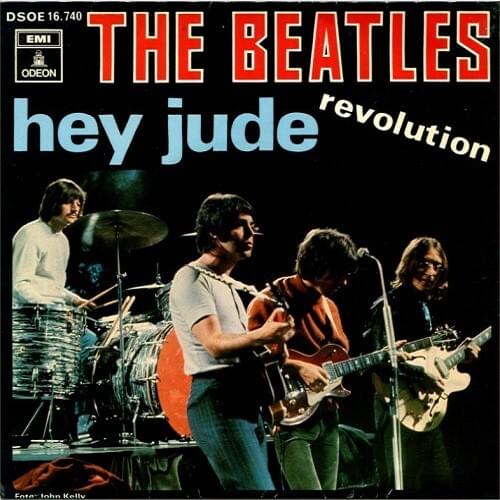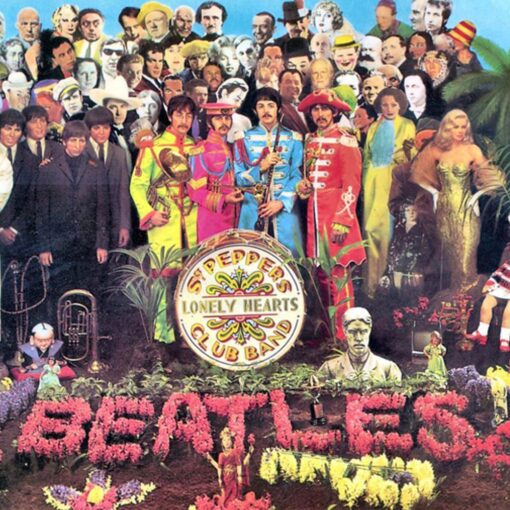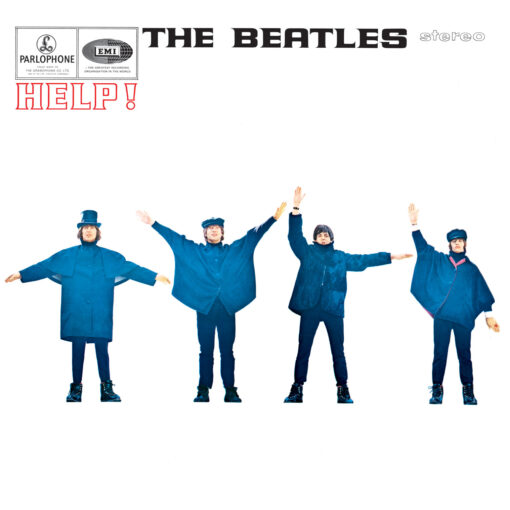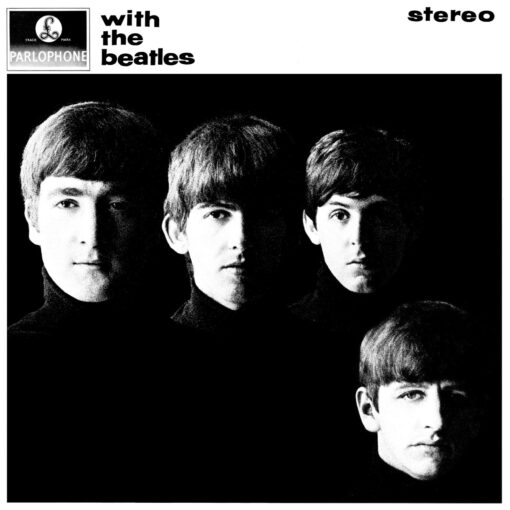- Published on 1965 – 1970
- Author: Lennon/McCartney
- Track 13 on “The Beatles 1967-1970” (Blue Album)
- Track / on “Past Masters Volume 2“
JOHN 1968: “Well, when Paul first sang ‘Hey Jude’ to me… or played me the little tape he’d made of it… I took it very personally. ‘Ah, it’s me,’ I said, ‘It’s me.’ He says, ‘No, it’s me.’ I said, ‘Check. We’re going through the same bit.’ So we all are. Whoever is going through a bit with us is going through it, that’s the groove.”
JOHN 1972: “That’s his best song.”
PAUL 1974: “I remember I played it to John and Yoko, and I was saying, ‘These words won’t be on the finished version.’ Some of the words were: ‘The movement you need is on your shoulder,’ and John was saying, ‘It’s great!’ I’m saying, ‘It’s crazy, it doesn’t make any sense at all.’ He’s saying, ‘Sure it does, it’s great.’”
JOHN 1980: “He said it was written about Julian. He knew I was splitting with Cyn and leaving Julian then. He was driving to see Julian to say hello. He had been like an uncle. And he came up with ‘Hey Jude.’ But I always heard it as a song to me. Now I’m sounding like one of those fans reading things into it… Think about it: Yoko had just come into the picture. He is saying. ‘Hey, Jude’– ‘Hey, John.’ Subconsciously, he was saying, ‘Go ahead, leave me.’ On a conscious level, he didn’t want me to go ahead. The angel in him was saying, ‘Bless you.’ The devil in him didn’t like it at all, because he didn’t want to lose his partner.”
PAUL 1985: “I remember on ‘Hey Jude’ telling George not to play guitar. He wanted to do echo riffs after the vocal phrases, which I didn’t think was appropriate. He didn’t see it like that, and it was a bit of a number for me to have to ‘dare’ to tell George Harrison– who’s one of the greats– not to play. It was like an insult. But that’s how we did alot of our stuff.”
PAUL circa-1994: “There is an amusing story about recording it… Ringo walked out to go to the toilet and I hadn’t noticed. The toilet was only a few yards from his drum booth, but he’d gone past my back and I still thought he was in his drum booth. I started what was the actual take– and ‘Hey Jude’ goes on for hours before the drums come in– and while I was doing it I suddenly felt Ringo tiptoeing past my back rather quickly, trying to get to his drums. And just as he got to his drums, boom boom boom, his timing was absolutely impeccable.”
About “Hey Jude”

Released as a non-album single in August 1968, “Hey Jude” stands as an iconic testament to the creative brilliance of Paul McCartney, officially credited to the enduring Lennon-McCartney partnership. This track marked a historic moment for the Beatles, serving as their inaugural release under the Apple record label, a pivotal event known as the launch of the label’s “First Four” singles.
The song’s impact was nothing short of meteoric, ascending to the number-one spot in numerous countries worldwide. It clinched the title of the year’s highest-selling single in the UK, the US, Australia, and Canada. Its reign at the top of the Billboard Hot 100 for an astonishing nine consecutive weeks in 1968 set a record that endured for nearly a decade. With approximately eight million copies sold, “Hey Jude” secures its place as an everlasting gem, a perennial favorite frequently lauded by music critics on their lists of all-time greats.
The genesis of “Hey Jude” unfolded amidst a tumultuous period for the Beatles. Originally conceived as “Hey Jules,” Paul McCartney composed this heartfelt ballad to console John Lennon’s son, Julian, in the wake of Lennon’s separation from his wife for the enigmatic Yoko Ono. The lyrics exude an uplifting spirit amidst melancholy, urging “Jude” to embrace the quest for love and fulfillment. The song takes an audacious turn after the fourth verse, segueing into a transcendent coda adorned with the distinctive “Na-na-na na” refrain, an extended passage that captivates for over four minutes.
Notably, “Hey Jude” marked a technological milestone for the Beatles, being the first composition to grace the eight-track recording equipment. Recorded at Trident Studios in central London during the creation of their eponymous double album, commonly known as the “White Album,” the process was not without its tensions. A dispute between McCartney and George Harrison over the song’s guitar arrangement punctuated the sessions. Meanwhile, Ringo Starr briefly departed the group, returning just in time for the filming of the promotional video, helmed by director Michael Lindsay-Hogg and premiering on David Frost’s UK television show. This performance beautifully encapsulated the song’s themes of hope and unity, as the studio audience harmoniously joined the Beatles in the uplifting coda.
Spanning over seven minutes, “Hey Jude” held the distinction of being the lengthiest single to conquer the British charts at the time. Its innovative arrangement and expansive coda sparked a wave of imitations well into the early 1970s. In 2013, Billboard magazine bestowed upon it the title of the 10th “biggest” song of all time, measured by chart success. McCartney, undeterred by Lennon’s tragic passing in 1980, has steadfastly continued to perform “Hey Jude” in concert, leading audiences in a spirited rendition of its iconic coda. Notably, both Julian Lennon and McCartney have vied successfully at auctions for cherished memorabilia connected to the song’s inception, underscoring its enduring significance.
Meaning of “Hey Jude”
The lyrics offer a message of support and encouragement, urging Jude (or Julian) to embrace opportunities and seek love, even in the face of sadness or adversity. The song’s uplifting melody and positive lyrics have resonated with many listeners over the years, making it an enduring anthem of hope and encouragement.
“Hey Jude” is often considered one of the greatest and most influential songs in the history of popular music, and its meaning has been interpreted in various ways by different listeners. Some see it as a universal message of support and comfort, while others connect it to the specific circumstances of Julian Lennon and his parents’ divorce.
The song’s timeless appeal lies in its ability to convey a sense of empathy, resilience, and the belief in brighter days ahead.
Personnel
- Paul McCartney – lead vocal, piano, bass guitar, handclaps
- John Lennon – backing vocal, acoustic guitar, handclaps
- George Harrison – backing vocal, electric guitar, handclaps
- Ringo Starr – backing vocal, drums, tambourine, handclaps




2 thoughts on ““Hey Jude””